History
of the Facit Calculators
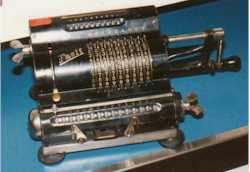 The
first calculator bearing the Facit name was an Odhner-type
machine made in 1918 by the firm of Axel Wibel in Stockholm. In 1924,
Wibel's company was taken over by the Åtvidaberg Industries, which later
adopted the Facit name for all of its products. The
first calculator bearing the Facit name was an Odhner-type
machine made in 1918 by the firm of Axel Wibel in Stockholm. In 1924,
Wibel's company was taken over by the Åtvidaberg Industries, which later
adopted the Facit name for all of its products.
Facit calculators are of three main types, i.e. the hand-cranked variety with lever input (as the very early model illustrated at the left); the hand-cranked variety with keyboard input as originated by Rudin in 1932 as the model T; and the electrically-powered calculating machines, the first of which was offered in 1934 as the model E. |
|
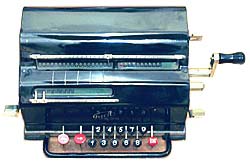 Facit T |
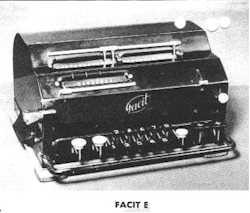 |
| The models TK
and EK, both introduced in 1936, were equipped with sliding quotient
coupling (dispensing the need to fill out the dividend with zeroes). The
semi-automatic Model EA of 1939 featured
automatic division and automatic shifting when multiplying. All the
electric models were equipped with "stop division" which brought
the mechanism to a halt as soon as the accumulator registered zeroes or
nines.
The machine illustrated below is the hand-cranked model TK with sliding quotient coupling. Also depicted is its electrical counterpart, the model NEK, introduced in 1943, being an improved version of the old model EK, fitted with a better drive unit less sensitive to mains voltage variations. The year 1943 also saw the introduction of the model NEA, which of course was an improved version of the EA. With the introduction of the 'N'-series, the Facit calculators changed colors to green. |
|
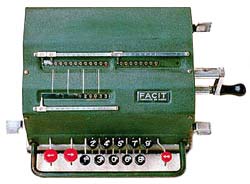 Facit TK |
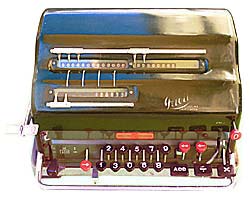 Facit EA |
|
Finally in 1945 the model ESA arrived, featuring both automatic division and automatic multiplication, followed in 1949 by the model ESA-0 with electric clearing of all registers. |
|
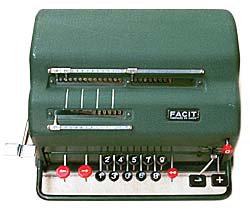 Facit NEK |
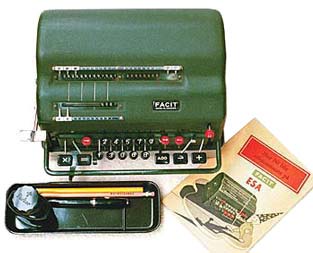 Facit ESA |
| Later-model
Facits, beginning with Model NTK of 1954,
and the large-capacity model C 1-19
illustrated below, were built into casing designed by Sigvard Bernadotte, a
member of the Swedish Royal family.
In its new disguise, the model NEK was re-christened CE 1-13; the NEA became a CS 1-13, and finally the top-model ESA-0 changed its name to CA 1-13. The NTK finally was called C 1-13, an early specimen of which is illustrated below. |
|
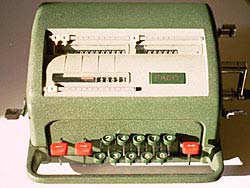 Facit NTK |
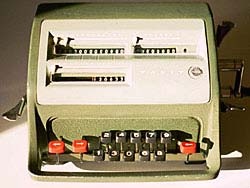 Facit C1-13 |
| Development of
Facit's mechanical calculators continued well into the electronic era. The
last electric leaving the factory was a CA 1-13,
production being discontinued in 1973; the last hand-cranked a C1-13,
being manufactured in India as late as in 1982.
The Bernadotte Facits changed colors from green (1954-57) to different shades of grey (1957-67) in line with the company's typewriters. From 1967 and on, they had white, yellow or black plastic covers. |
|
|
|
|
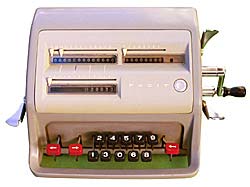 Facit C1-13 1957-1960 |
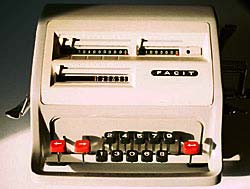 Facit C1-13 1960-1964 |
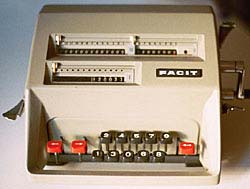 Facit C1-13 1964-1967 |
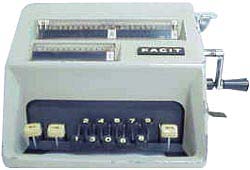 Facit C1-13 1964-1967 |
|
|
|
| Also
illustrated is the interesting but short-lived Model CM
2-16 of 1959, an electrical version of which was introduced in 1962
and called CA 2-16. Unlike their
predecessors, the C 2-series used the 'standard' keyboard layout. In later
years, these low-slung, slightly angular machines had white plastic covers
and were called Facit 1004 and 1007. The C
2-series was discontinued in 1973.
The first electronic Facit calculator was the series 1120, manufactured by Sharp of Japan and introduced in 1966. Two years later, in 1968, a large new factory in Örsätter outside of Åtvidaberg was opened, its aim being to produce a "native Swedish" electronic calculator. But it was already too late to take up competition with the Japanese. Five years after the merger with Electrolux, all production of Facit calculators was finally discontinued in 1977. |
|
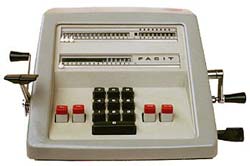 Facit CM 2-16 |
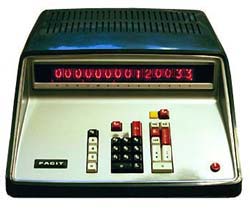 Facit 1122 |
|
See also "Family tree of the Facit calculators": http://w1.131.telia.com/~u13101111/facitsv.html |
|
|
Thanks to the 'Facit men' Lennart Lundgren, Kenneth Mårtensson & Stig K Andersson. |
|
|
Copyright © Christofer Nöring, in March 2000 All rights reserved |
|